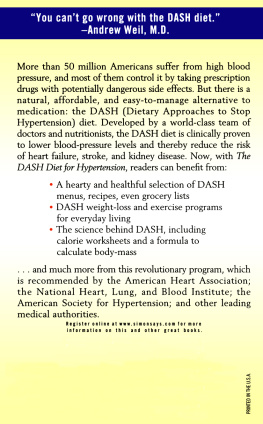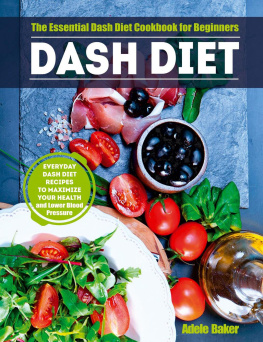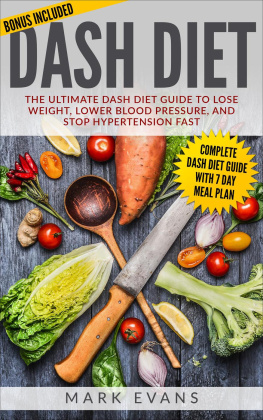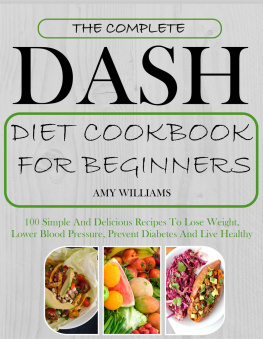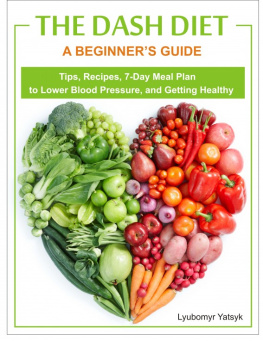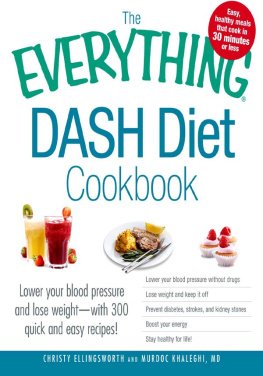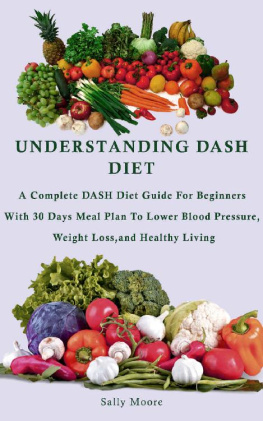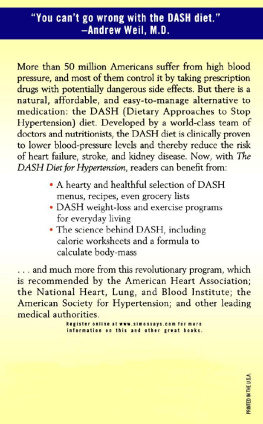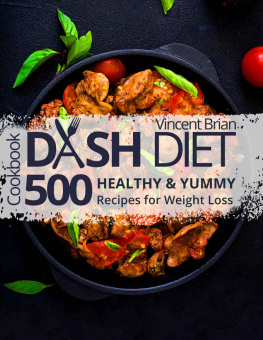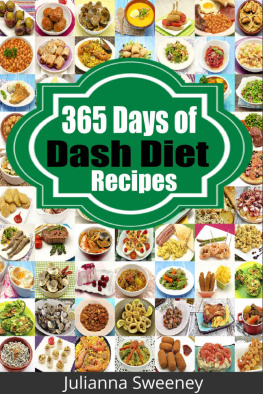Excellent! A medication-free alternative to help millions of Americans lower their high blood pressure and live healthier, longer lives.
Dr. Patricia Elmer, member Nutrition Committee, American Heart Association
ABOUT THE AUTHORS
THOMAS MOORE, M.D., has been a member of the Harvard Medical School and Boston University faculties for twenty-five years and has published more than 100 scholarly articles and book chapters on hypertension. He lives in Boston.
LAURA SVETKEY, M.D., is a professor of medicine and director of the Hypertension Center at Duke University Medical Center in Durham, North Carolina, where she lives.
PAO-HWA LIN, PH.D., has been a faculty member at the Sarah W. Stedman Nutrition Center at Duke University Medical Center since 1992. She lives in Durham.
NJERI KARANJA, PH.D., is a research scientist at the Kaiser Permanente Center for Health Research. She lives in Portland, Oregon.
MARK JENKINS is a freelance writer and the author of many successful books. He lives in Marthas Vineyard, Massachusetts.

| POCKET BOOKS, a division of Simon & Schuster, Inc.
1230 Avenue of the Americas, New York, NY 10020
www.SimonandSchuster.com |
Copyright 2001 by Thomas Moore, Laura Svetkey, Lawrence Appel, George Bray, and William Vollmer
All rights reserved, including the right to reproduce this book or portions thereof in any form whatsoever. For information address The Free Press, 1230 Avenue of the Americas, New York, NY 10020
ISBN: 0-7434-1007-6
eISBN-13: 978-1-43914-059-8
First Pocket Books printing March 2003
eBook edition updated July 2011
10 9 8 7 6 5 4 3 2 1
POCKET and colophon are registered trademarks of Simon & Schuster, Inc.
Cover design by Anna Dorfman
Printed in the U.S.A.
A CKNOWLEDGMENTS

Members of the DASH Collaborative Research Group
Boston University School of Medicine: T. J. Moore
Brigham and Womens Hospital and Harvard Medical School: N. Alexander, J. Belmonte, F. Bodden, L. Cashman, P. Conlin, Y. Courtney, B. Cox, J. Dyer, A. Ghosh, J. Hackett, E. Hamilton, T. Holiday, L. Jaffe, J. Karimbakis, C. Larson, M. MacDonald, M. McCullough, D. McDonald, J. McKnight, P. McVinney, D. Moeller, T. J. Moore, P. Morris, M. Myrie, K. Nauth, K. Osborn, E. Penachio, S. Redican, F. M. Sacks, J. Sales, J. Swain, Z. Than, K. Weed;
Duke University Medical Center: J. Abbott, K. Aicher, J. Ard, C. Bales, J. Baughman, A. Bohannon, B. Brown, L. Carter, M. Drezner, R. Fike, B. Graves, K. Hoben, J. Huang, L. Johnson-Pruden, P-H. Lin, S. Norris, T. Phelps, C. Plaisted, I. Reams, P. Reams, T. Ross, F. Rukenbrod, T. Shusterman, L. P. Svetkey, E. Ward;
Johns Hopkins University: J. Abshere, L. J. Appel, D. Bengough, L. Bohlman, B. Caballero, S. Cappelli, J. Charleston, L. Clement, P. Coleman, C. Dahne, F. Dennis, S. Dobry, K. Eldridge, T. Erlinger, A. Fouts, B. Harnish, C. Harris, B. Horseman, M. Jehn, S. Kritt, S. Kumanyika, J. Lambert, S. Lee, E. Levitas, P. McCarron, E. R. Miller, N. Muhammad, M. Nagy, B. Peterson, D. Rhodes, V. Shank, T. Shields, T. Stanger, A. Thomas, E. Thomas, R. Weiss, E. Wilke, W. Wong; Beltsville Human Nutrition Research Center, U.S. Department of Agriculture: S. Burns, E. Lashley, J. T. Spence;
Kaiser Permanente Center for Health Research: N. Adams, M. Aickin, M. Allison, G. Ansell, S. Baxter, N. Becker, S. Craddick, L. Diller, B. Doster, C. Eddy, D. Ernst, S. Gillespie, R. Gould, T. Haswell, L. Haworth, F. Heinith, M. Hornbrook, J. Inglish, N. Karanja, K. Kirk, P. LaChance, R. Laws, M. Leitch, W. R. Li, L. Massinger, M. McMurray, G. Meltesen, G. Miranda, S. Mitchell, J. Murphy, E. OConnor, K. Pearson, K. Pedula, N. Redmond, J. Reinhardt, J. Rice, P. Runk, R. Schuler, C. Souvanlasy, M. Sucec, T. M. Vogt, W. M. Vollmer;
National Heart, Lung and Blood Institute: C. Brown, J. A. Cutler, M. Evans, E. Obarzanek, M. A. Proschan, D. G. SimonsMorton;
Pennington Biomedical Research Center, Louisiana State University: G. A. Bray, C. M. Champagne, S. Crawford, I. Culbert, F. Greenway, D. Harsha, J. Ihrig, B. M. Kennedy, B. McGee, E. Meador, J. Perault, D. H. Ryan, D. Sanford, A. Sawyer, S. Smith, R. Tulley, J. Vaidyanathan, M. M. Windhauser, P. J. Wozniak;
Virginia Polytechnic Institute: K. Phillips, K. K. Stewart; Washington University School of Medicine.
C ONTENTS

P ART O NE
Why We Need DASH and How It Works
P ART T WO
Making the Most of Your Commitment
P ART T HREE
DASH in Action
P ART F OUR
DASH Menu Plans and Recipes
P REFACE

For the first time a practical diet has been created that harnesses the blood-pressure-lowering potential of healthful foods. This diet works because it contains the amounts and combinations of key nutrients needed to lower blood pressure. It lowers blood pressure as much as most prescription blood pressure medications, and it works for men and women, whites and blacks, young and old. It is named the DASH diet after the landmark study, called Dietary Approaches to Stop Hypertension, that proved it lowered blood pressure to a much healthier level within 14 days. The name of the diet also hints at its speed, because it is fast-acting as well as effective.
So confident are we that the DASH diet can improve your blood pressure that at the very beginning of this book we issue a 14-day challenge: we challenge you to spend two weeks eating the DASH diethearty meals of familiar, common foods with an emphasis on fruits, vegetables, and low-fat dairy products in a prescribed combination of servingsso you can see at the end of that time how your blood pressure has improved significantly. When you see how much it has improved, we believe you will want to continue the DASH diet for the rest of your life.
If you have been taking blood pressure medication, your doctor may eventually be able to take you off it if youre willing to remain on the DASH diet. Of course, under no circumstances should you go off your blood pressure medication without clearance from your health-care professional.
The DASH diet was developed for people who have high blood pressure (also known as hypertension), but there is a strong argument to be made that everyone should eat the DASH way. Blood pressure naturally goes up as you age, and the likelihood is that if you live long enough, you will eventually develop this condition (half of Americans over 65 years old have high blood pressure). Following the DASH diet enables you to halt this process.
The DASH diet is simple, but at first it may not seem easy. It involves changing eating habits youve learned over a lifetime. But the fact is that its do-able, and in this book we provide you with all the information you need to follow the DASH way of eating. With the DASH diet you wont need a calculator every time you prepare a meal. It is based on easy-to-understand servings of whole foods, not
Next page
